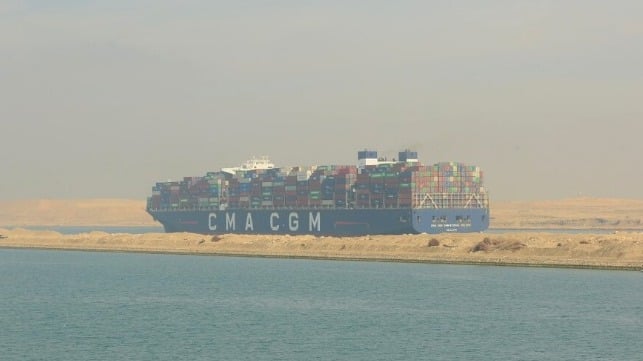Maersk and CMA CGM Restore Some Red Sea Transits While Industry is Divided

The major carriers remain divided on sending vessels through the Suez Canal and the Red Sea as they continue to acknowledge that safety remains a concern. With the deployment of the international security coalition in the region, several carriers including Maersk are beginning to restore some services while others continue to say it is too soon due to the instability and safety issues.
After showing that 15 routes were being impacted by the diversions around the Cape of Good Hope, Maersk has begun to reverse some of the changes on an individual case. In a customer advisory on Sunday, December 24, Maersk said it was preparing to allow vessels to resume the transit and was working on a plan for the first vessels to make the transit.
The schedules posted to the company’s website now show ships on several of the routes listed as “Continue via Suez Canal,” while on the same route, other vessels are still listed as “Diverted via Cape of Good Hope.” Reuters reports in total “several dozen” container vessels will be restored to the routes via the Red Sea after Maersk began on December 19 rerouting all ships around Africa. Maersk paused all transits on December 15 after one of its ships was among those targeted by the Houthis for an attack.
CMA CGM yesterday also reported to customers that some vessels have made the transit through the Red Sea and that it was “currently devising plans for the gradual increase in the number of vessels transiting through the Suez Canal.”
“We are taking all possible steps to minimize delays and inconvenience to our vessels and cargoes whilst making sure maximum safety is ensured at all times in this uncertain context still prevailing in the south Red Sea area,” the French carrier wrote in its December 26 advisory to customers.
Carriers are anxious to maintain security while also wanting to reduce the delays and disruptions to their service, all of which are adding to the costs. Analysts highlight that the diversion around Africa can add up to two weeks for a vessel sailing from Asia to Northern Europe and nearly three weeks for services into the Mediterranean from Asia. Even sailings to the U.S. East Coast require an added week of transit time to go around Africa.
Bloomberg Intelligence wrote today in an update that container freight spot rates are up as much as 26 percent over the past four weeks since the security issues began. The disruptions also mean that additional capacity and vessels need to be made available if the carriers are to maintain their scheduled departures.
The international coalition has according to Bloomberg advised the carriers that the risk appears to be greatest during the daylight hours. All the drone attacks and missiles have been fired from Yemen during the daylight with Bloomberg reporting the coalition said it may also be harder for the attackers to hit vessels at night.
Despite this, other carriers are reporting they will continue to divert their ships. Hapag-Lloyd is reassessing its decision several times a week. They reported that their “crisis committee was in session today,” and that they continue to believe at this time it is too dangerous. They however said they would review the decision again on Friday.
After one of its vessels was attacked yesterday off the coast of Yemen, MSC Mediterranean Shipping Company said “Until their safety can be ensured MSC will continue to reroute vessels booked for Suez transit via the Cape of Good Hope.”
Many of the second-tier container carriers had followed the lead of the industry majors in rerouting their vessels. CNN reports it contacted Evergreen Line today which referred it back to the December 18 statement from the carrier announcing that it would be rerouting vessels “until further notice.”
While the container carriers have been united in the efforts to divert vessels, other segments are still using the Red Sea and Suez. AIS signals for example show bulkers and crude oil tankers making the transit. The Suez Canal however has not provided an update since mid-December on its daily transits.
